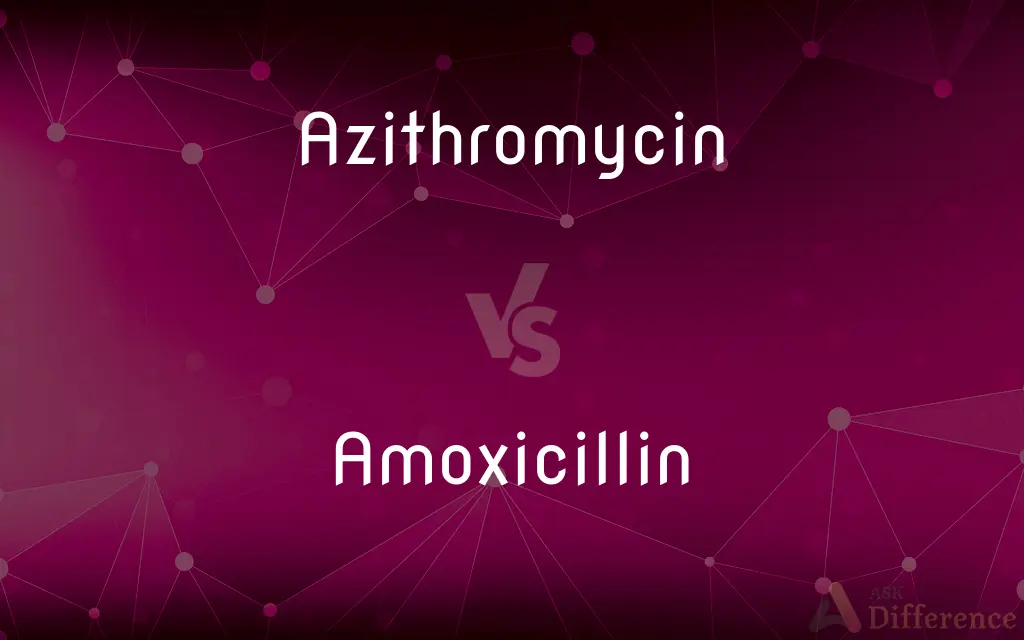Azithromycin vs. Amoxicillin — What's the Difference?
Edited by Tayyaba Rehman — By Fiza Rafique — Updated on September 29, 2023
Azithromycin is a macrolide antibiotic, while Amoxicillin is a penicillin antibiotic; both treat bacterial infections but differ in spectrum and structure.

Difference Between Azithromycin and Amoxicillin
Table of Contents
ADVERTISEMENT
Key Differences
Azithromycin and Amoxicillin are both antibiotics prescribed to treat bacterial infections. However, Azithromycin belongs to the macrolide class, while Amoxicillin is a penicillin antibiotic.
While both Azithromycin and Amoxicillin are effective against a variety of bacterial strains, Azithromycin is often used for respiratory, ear, and sinus infections, whereas Amoxicillin is commonly prescribed for infections of the middle ear, tonsils, throat, urinary tract, and skin.
The molecular structures of Azithromycin and Amoxicillin are distinct. Azithromycin has a complex structure with a macrocyclic lactone ring, while Amoxicillin is characterized by its beta-lactam ring.
In terms of side effects, Azithromycin might cause problems like stomach upset or diarrhea. Amoxicillin, on the other hand, can lead to allergic reactions in some individuals, particularly those allergic to penicillin.
Azithromycin typically has a longer half-life than Amoxicillin. This means that Azithromycin is often administered less frequently, sometimes once daily or even less, whereas Amoxicillin is usually taken multiple times a day.
ADVERTISEMENT
Comparison Chart
Antibiotic Class
Macrolide
Penicillin
Common Uses
Respiratory, ear, and sinus infections
Middle ear, tonsils, throat, urinary tract, and skin infections
Molecular Structure
Contains a macrocyclic lactone ring
Contains a beta-lactam ring
Common Side Effects
Stomach upset, diarrhea
Allergic reactions, diarrhea
Dosage Frequency
Typically once daily or less
Usually multiple times a day
Compare with Definitions
Azithromycin
Used to treat a variety of bacterial infections.
The doctor prescribed Azithromycin for my sinus infection.
Amoxicillin
Often taken multiple times a day.
I need to take Amoxicillin three times daily for a week.
Azithromycin
Known for a longer half-life compared to some other antibiotics.
The long half-life of Azithromycin allows for less frequent dosing.
Amoxicillin
Can cause allergic reactions in individuals allergic to penicillin.
Always inform your doctor if you're allergic to penicillin before taking Amoxicillin.
Azithromycin
Often administered once daily.
I take Azithromycin once every 24 hours as instructed.
Amoxicillin
Used to treat a wide range of bacterial infections.
The dentist prescribed Amoxicillin after my tooth extraction.
Azithromycin
A macrolide antibiotic.
Azithromycin is often prescribed for respiratory infections.
Amoxicillin
A penicillin-type antibiotic.
Amoxicillin is derived from the penicillin family.
Azithromycin
Effective against certain Gram-positive and Gram-negative bacteria.
Azithromycin can be used against various bacterial strains.
Amoxicillin
Effective mainly against Gram-positive bacteria.
Amoxicillin is particularly useful against streptococcal infections.
Azithromycin
Azithromycin is an antibiotic medication used for the treatment of a number of bacterial infections. This includes middle ear infections, strep throat, pneumonia, traveler's diarrhea, and certain other intestinal infections.
Amoxicillin
Amoxicillin is an antibiotic used to treat a number of bacterial infections. These include middle ear infection, strep throat, pneumonia, skin infections, and urinary tract infections among others.
Azithromycin
A macrolide antibiotic, C38H72N2O12, used to treat a variety of bacterial infections.
Amoxicillin
A semisynthetic penicillin, C16H19N3O5S, having an antibacterial spectrum of action similar to that of ampicillin.
Azithromycin
(pharmaceutical drug) A semisynthetic macrolide antibiotic C38H72N2O12 (trademarks Zithromax, Z-PAK) that is derived from erythromycin and is used especially as an antibacterial agent.
Amoxicillin
(pharmaceutical drug) A moderate-spectrum, bacteriolytic beta-lactam antibiotic C16H19N3O5S closely related to ampicillin and with similar properties, but more readily absorbed when taken orally. It is used to treat bacterial infections caused by susceptible microorganisms.
Amoxicillin
An antibiotic; a semisynthetic oral penicillin (trade names Amoxil and Larotid and Polymox and Trimox and Augmentin) used to treat bacterial infections
Common Curiosities
Can both Azithromycin and Amoxicillin treat bacterial infections?
Yes, both are antibiotics used to treat bacterial infections, though their spectra differ.
Is Azithromycin typically dosed once daily?
Yes, Azithromycin is often administered once daily or even less frequently.
Is Azithromycin a type of penicillin?
No, Azithromycin is a macrolide antibiotic, not a penicillin.
Which has a longer half-life, Azithromycin or Amoxicillin?
Azithromycin has a longer half-life compared to Amoxicillin.
How often should I take Amoxicillin for an infection?
Typically multiple times a day, but always follow your doctor's instructions.
Can I take Azithromycin if I'm allergic to penicillin?
Generally, yes, but always consult a doctor about any allergies before taking medications.
Which antibiotic is typically used for skin infections, Azithromycin or Amoxicillin?
Amoxicillin is commonly prescribed for skin infections.
Is Amoxicillin effective against respiratory infections?
Yes, but Azithromycin is more commonly prescribed for respiratory infections.
Can Amoxicillin cause allergic reactions?
Yes, especially in individuals allergic to penicillin.
Which antibiotic is more effective against Gram-negative bacteria, Azithromycin or Amoxicillin?
Azithromycin is effective against certain Gram-negative bacteria.
Is Azithromycin known to treat ear infections?
Yes, Azithromycin can be prescribed for ear infections.
Share Your Discovery

Previous Comparison
Hitherto vs. Thitherto
Next Comparison
Yea vs. YesAuthor Spotlight
Written by
Fiza RafiqueFiza Rafique is a skilled content writer at AskDifference.com, where she meticulously refines and enhances written pieces. Drawing from her vast editorial expertise, Fiza ensures clarity, accuracy, and precision in every article. Passionate about language, she continually seeks to elevate the quality of content for readers worldwide.
Edited by
Tayyaba RehmanTayyaba Rehman is a distinguished writer, currently serving as a primary contributor to askdifference.com. As a researcher in semantics and etymology, Tayyaba's passion for the complexity of languages and their distinctions has found a perfect home on the platform. Tayyaba delves into the intricacies of language, distinguishing between commonly confused words and phrases, thereby providing clarity for readers worldwide.














































